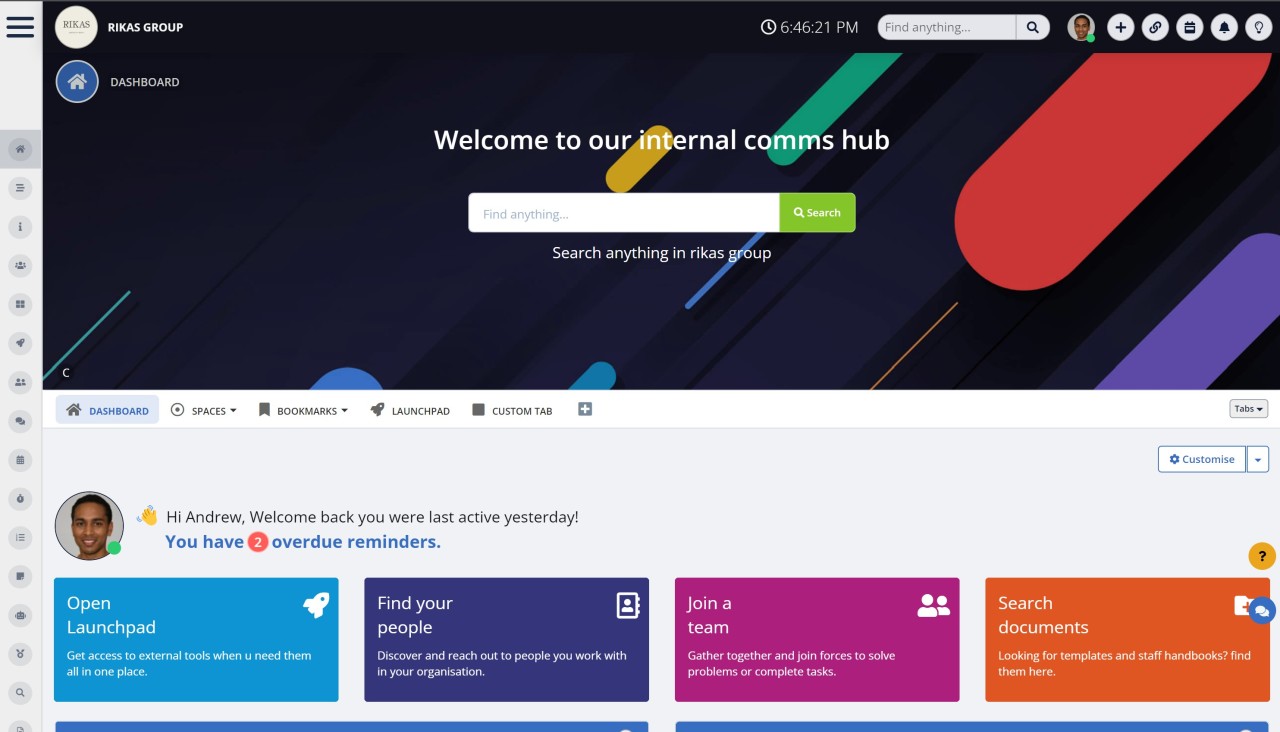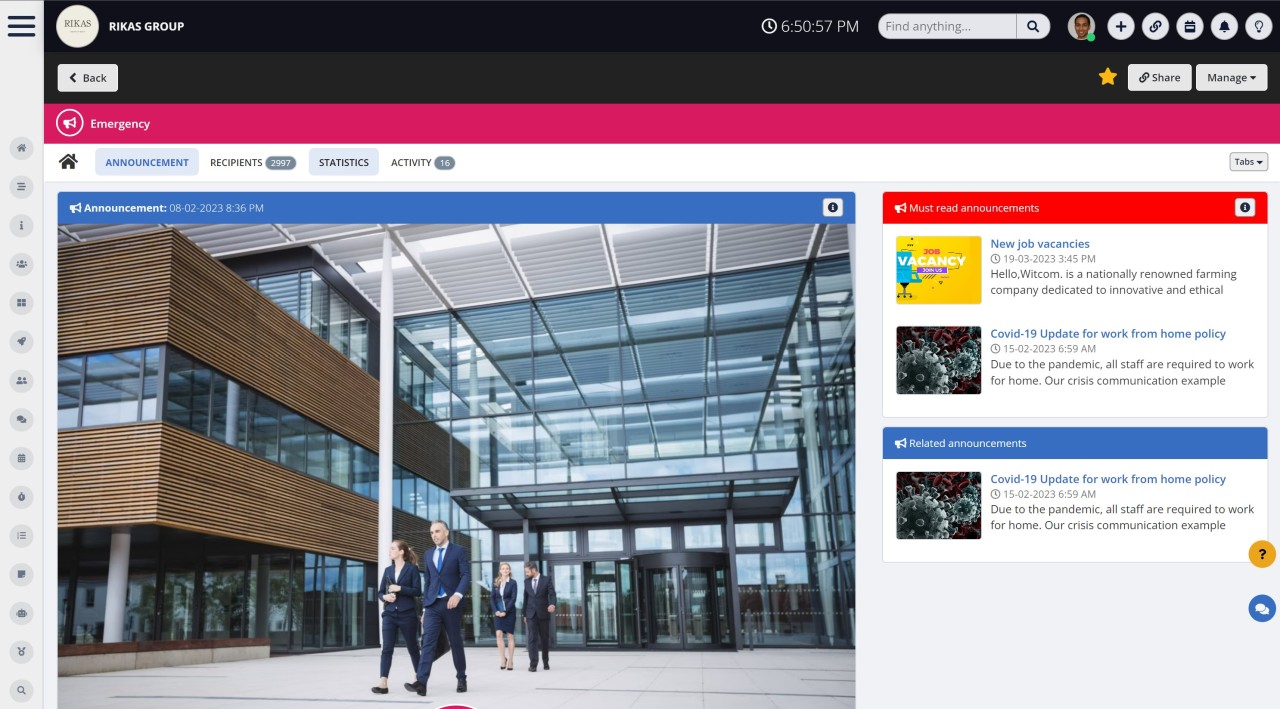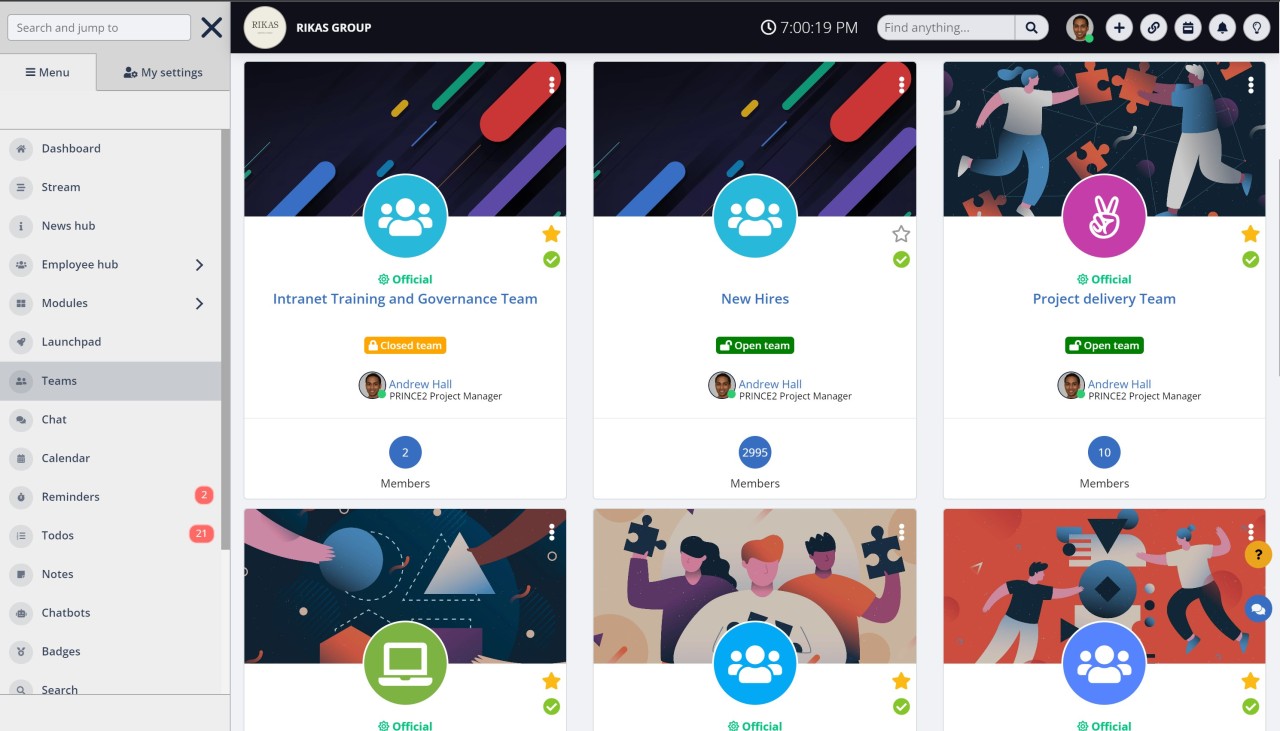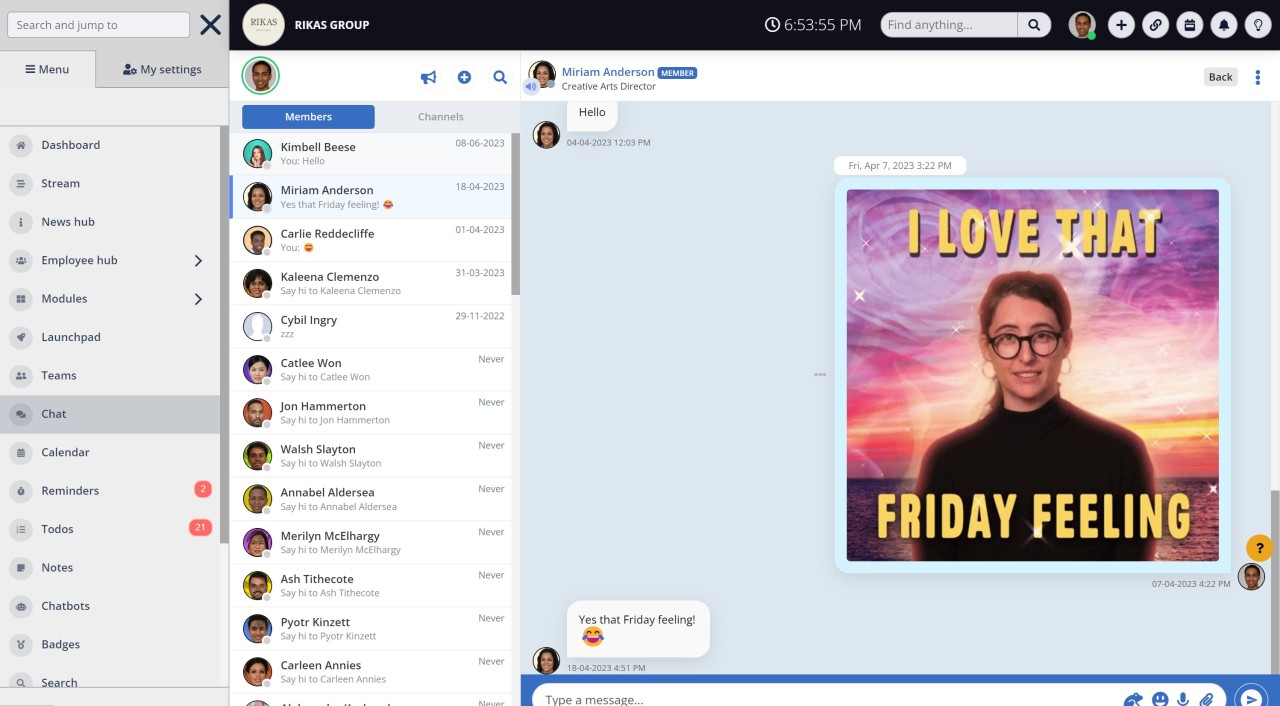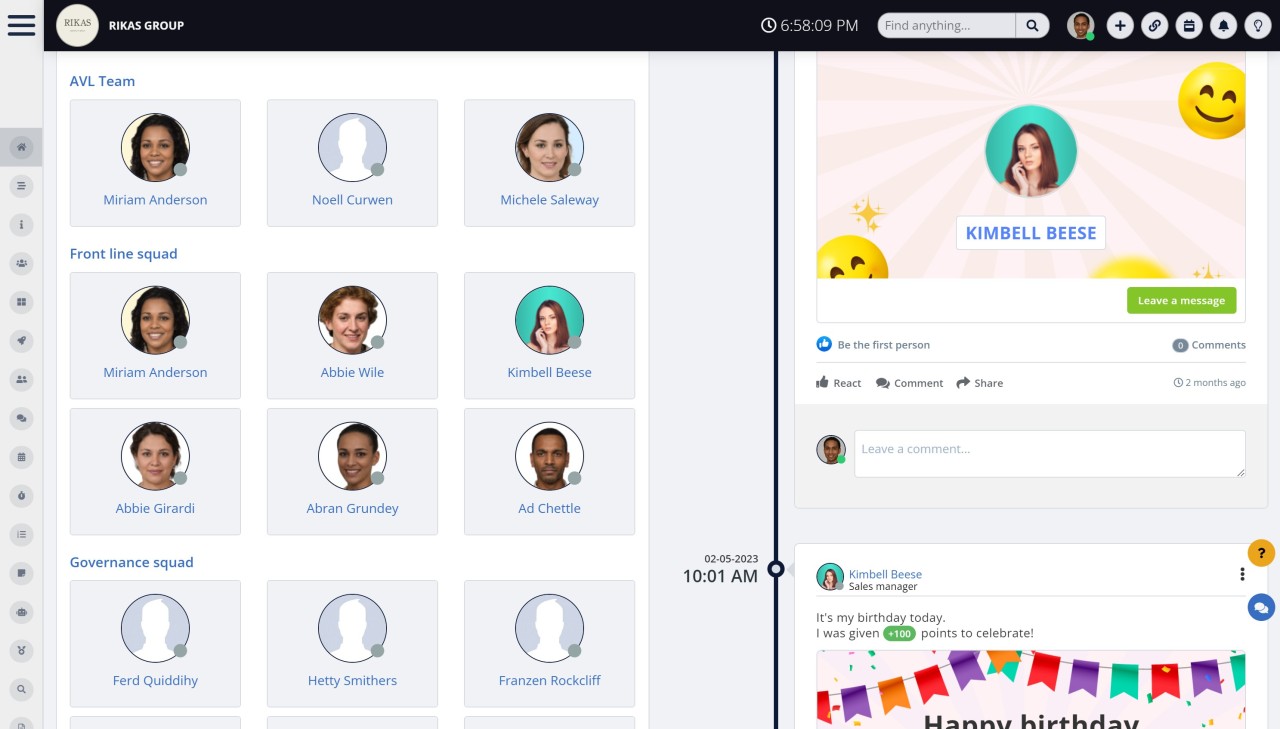Insight Blog
Agility’s perspectives on transforming the employee's experience throughout remote transformation using connected enterprise tools.
26 minutes reading time
(5136 words)
Featured
What is Internal Communication Tools? The Power of Internal Comms Tools for Business Success
By the end of this article, you will have a clear understanding of how to leverage these tools to drive your organization's growth and outperform your competitors.
In today's fast-paced and interconnected world, effective communication within an organization is crucial for achieving business success.
What is Internal communication tools play a pivotal role in facilitating seamless collaboration, enhancing employee engagement, and streamlining workflows.
Believe that an internal communications tools is not worth investing your time in?
Neglecting internal communication can genuinely and adversely impact various aspects, ranging from employee engagement and retention to your overall financial performance.
By utilizing appropriate tools, you can enhance your company's communication practices, which serves as an excellent foundation for establishing and executing a scalable communications strategy.
By the end of this article, you will have a clear understanding of how to leverage these tools to drive your organization's growth and outperform your competitors.
What are internal communication tools?
Internal communication tools for small business are software applications designed to facilitate employee communication within companies.
These tools aid in optimizing the flow of information between managers and employees, as well as fostering efficient communication among employees.
Moreover, they contribute to minimizing the necessity of in-person meetings, leading to significant time and cost savings.
Internal communication tools allows employees to connect, share information, collaborate on projects, and align their efforts towards achieving common goals.
The importance of internal communication tools cannot be overstated.
They serve as the backbone of any successful organization, facilitating the exchange of ideas, knowledge sharing, and promoting a sense of unity and purpose among team members.
By leveraging these tools, businesses can enhance employee productivity, boost morale, and ultimately drive innovation and growth.
Why is effective internal communication so important?
Inadequate internal communications can drain your resources, impact customer satisfaction, and hinder organizational success.
Studies reveal that 86% of employees and executives attribute workplace failures to ineffective collaboration and communication. Without clear communication channels, goals and objectives remain ambiguous, leaving room for misinformation and increasing the likelihood of errors and misunderstandings.
Change initiatives, instead of sparking possibility, often trigger stress and uncertainty among employees. In such situations, effective communication is not just important, it's crucial. It plays a pivotal role in crisis management, coordinating decisive action and uniting everyone to navigate challenges together.
Furthermore, being left out of essential communications can make employees feel neglected, undervalued, or misled, affecting productivity and morale and increasing turnover rates. According to The Society for Human Resource Management (SHRM), replacing an employee can cost up to six to nine months of their salary, in addition to the disruption and potential negative impact on others' perceptions of your business.
Furthermore, the effects of poor internal communication can extend beyond the organization. If employees are not aligned or lack clarity on key messaging and company values, the customer service they provide is likely to be inconsistent. This inconsistency can be detrimental to your brand reputation, highlighting the indirect but significant impact of internal communication on external stakeholders.
Connect your entire team, using our internal communication software. Try AgilityPortal free for 14 days no credit card required.
Examples of workplace internal communication platform
In the workplace, communication takes on various forms, encompassing a wide range of methods and channels. Nevertheless, amidst this diversity, several fundamental interactions consistently occur in almost every professional setting. Here are some Internal communication tools examples
Management to employee communication
This type of internal communication focuses on the structure of the organization and the delivery of information from managers to individual contributors. It can range from regular one-on-one meetings with managers to quick direct messages to confirm progress towards meeting deadlines.
Employee-up communication
To enable employees to communicate important information to upper management, emphasis should be placed on employee-up communication. This type of communication tends to be collaborative, as it involves the entire workforce.
Peer-to-peer communication
Whether it's within your team or between individual contributors, fostering peer-to-peer communication is essential. This type of communication occurs throughout the day among staff members.
Crisis communication
During a crisis, organizations depend heavily on internal communication to outline strategies, systems, and processes effectively. To ensure information is shared in a universally accessible and professional format, converting MS Excel to PDF becomes essential. PDFs preserve the formatting and integrity of crucial data, ensuring consistency across all communication channels.
Given the unpredictable nature of crises, it is vital for organizations to plan ahead and include streamlined tools like Excel-to-PDF conversion in their preparedness strategies. This ensures critical data can be shared quickly and efficiently when it matters most.
Change communication
Whether the change is minor or a major adjustment, effective communication is key to successful change management. Change communication should help employees understand the expected changes, their timing and reasons, and provide context on how the changes will impact the entire organization or specific teams.
Free ebook: How To Get Your Intranet Off The Ground
Key Benefits of Internal Communication Tools
In the fast-paced digital landscape of today, businesses undergo constant changes driven by technology. Within this dynamic environment, both managers and team members often find themselves unaware of the numerous communication tools at their disposal.
As a result, they may inadvertently waste valuable work hours conducting research to identify communication methods that are already implemented and accessible across the entire company.
To alleviate this unnecessary drain on time and resources, businesses can proactively address the issue by developing and disseminating an internal communication plan. This plan would serve as a comprehensive resource, providing team members with a compiled list of currently available communication tools and offering guidance on their effective utilization.
Such a plan would serve as a centralized information hub for project communication strategies within the company. Team members would be able to refer to this valuable resource to find answers to questions, here are a few of the benefits of internal comms tools.
You may want to read: Internal Communication Strategy: Benefits, Best Practices and How to Do It
1. Improved Collaboration and Knowledge Sharing
Internal communication tools provide a centralized platform where employees can collaborate on projects, share ideas, and exchange information effortlessly.
By breaking down communication silos, these tools foster a culture of collaboration, enabling teams to work together more efficiently and effectively.
This leads to enhanced problem-solving, accelerated decision-making, and increased productivity across the organization.
2. Enhanced Employee Engagement
Engaged employees are the lifeblood of any successful business. Internal communication tools empower organizations to keep their workforce informed, engaged, and motivated.
By providing regular updates, sharing company news, and recognizing individual and team achievements, these tools create a sense of belonging and purpose among employees.
This, in turn, leads to higher levels of job satisfaction, increased loyalty, and reduced turnover rates.
3. Streamlined Workflows and Increased Efficiency
Inefficient communication processes can hinder productivity and waste valuable time and resources. Internal communication tools streamline workflows by eliminating manual tasks, reducing reliance on email threads, and providing real-time communication channels.
From project management platforms to instant messaging apps, these tools enable seamless coordination, task assignment, and progress tracking.
As a result, organizations can optimize their operations, minimize errors, and achieve higher levels of efficiency.
4. Transparent and Effective Leadership Communication
Internal communication tools serve as a bridge between leadership and employees, enabling transparent and effective communication.
Through company-wide announcements, virtual town halls, or interactive Q&A sessions, leaders can convey their vision, values, and goals directly to the workforce.
This fosters trust, boosts morale, and ensures that employees feel connected to the broader organizational strategy.
What are the consequences of lack of internal communication?
The consequences of a lack of internal communication within an organization can be significant and wide-ranging.
To mitigate these consequences, organizations should prioritize establishing clear and transparent communication channels, fostering a culture of open dialogue, and utilizing various tools and platforms to facilitate effective internal communication among employees at all levels.
So what are the consequences of lack of internal communication?
Here are some of the potential consequences:
1.Misalignment and confusion
Without effective communication channels, employees may not be on the same page regarding goals, objectives, or strategies.
This can lead to confusion, duplication of efforts, and a lack of coordination among different teams or departments.
2.Decreased productivity
When there is a lack of internal communication, it becomes difficult for employees to collaborate efficiently.
Important information may not reach the right people at the right time, leading to delays in decision-making, missed deadlines, and decreased overall productivity.
3.Poor teamwork and morale
Communication is crucial for fostering a sense of teamwork and camaraderie among employees.
Without proper communication channels, employees may feel isolated, disconnected, and uninformed about the happenings within the organization.
This can lead to low morale, decreased job satisfaction, and increased employee turnover.
4.Increased conflicts and misunderstandings
Inadequate communication can result in misunderstandings and conflicts between team members.
Without clear instructions, expectations, or feedback, employees may make assumptions or misinterpret information, leading to friction and strained relationships within the workplace.
5.Decreased innovation and creativity
Effective internal communication encourages the sharing of ideas and information. When communication is lacking, employees may hesitate to share their thoughts, suggestions, or innovative solutions.
This can stifle creativity, hinder problem-solving, and limit the organization's ability to adapt and innovate.
6.Customer dissatisfaction
A lack of internal communication can have a direct impact on customer service.
If employees are not well-informed about product updates, customer feedback, or changes in policies, it can result in inconsistent or inadequate service delivery, leading to customer dissatisfaction and potential loss of business.
7.Missed opportunities
In a fast-paced business environment, opportunities can arise and fade quickly.
Without effective internal communication, organizations may miss out on important opportunities such as partnerships, collaborations, or market trends, which could have a significant impact on their growth and competitiveness.
Best Practices for Leveraging Internal Communication Tools
In today's fast-paced and interconnected world, effective internal communication is crucial for the success of any organization.
Internal communication tools play a vital role in facilitating seamless collaboration, improving employee engagement, and driving overall productivity.
The best practices for leveraging internal communication tools to enhance your organization's internal communication processes.
1.Choosing the Right Internal Communication Platform
Selecting the right internal communication platform is the first step towards optimizing your internal communication strategy.
It is essential to evaluate various platforms and choose one that aligns with your organization's specific needs and requirements.
Look for features such as real-time messaging, file sharing capabilities, team collaboration spaces, and integration options with other tools your teams already use.
2.Establishing Clear Communication Objectives
Before implementing any internal communication tool, it's crucial to define clear communication objectives.
What are the goals you want to achieve?
Whether it's improving cross-departmental collaboration, enhancing transparency, or streamlining information flow, clearly outlining your objectives will help you design your communication strategy accordingly.
3.Promoting Active Participation
Effective internal communication is a two-way process.
Encourage active participation from all employees by creating an inclusive environment that values their opinions and encourages feedback. Leverage internal communication tools to facilitate discussions, conduct surveys, and seek input on various topics.
This fosters a sense of ownership and engagement among employees.
4.Ensuring Mobile Accessibility
In today's mobile-driven era, ensuring mobile accessibility is essential for successful internal communication.
Choose a platform that offers a mobile application, allowing employees to stay connected and engaged on the go.
Mobile accessibility enables seamless communication, even for remote or field-based employees, fostering a culture of constant collaboration.
5.Utilizing Targeted Communication
Not all information needs to be shared with every employee.
Utilize targeted communication features provided by your internal communication tool to ensure relevant information reaches the right people.
By segmenting your workforce based on teams, departments, or roles, you can streamline communication and reduce information overload, leading to increased efficiency.
6.Encouraging Employee Recognition and Appreciation
Recognition and appreciation are powerful motivators that boost employee morale and job satisfaction.
Leverage your internal communication tools to create channels or spaces dedicated to celebrating employee achievements, milestones, and outstanding contributions.
This not only fosters a positive work culture but also encourages a sense of camaraderie among employees.
7.Integrating Multimedia for Engaging Content
Engaging content is crucial for capturing employees' attention and ensuring effective communication.
Internal communication tools often support multimedia integration, enabling you to create visually appealing content such as videos, infographics, or presentations.
Leverage these features to convey information in a more engaging and digestible format.
8.Providing Training and Support
Introducing a new internal communication tool may require some learning for employees.
Ensure you provide comprehensive training and ongoing support to help them maximize the tool's potential. Conduct workshops, webinars, or create knowledge bases to familiarize employees with the tool's features and functionalities.
9.Monitoring and Analyzing Communication Metrics
To continuously improve your internal communication strategy, it's crucial to monitor and analyze communication metrics.
Most internal communication platforms offer analytics dashboards that provide insights into metrics like message engagement, readership, and response rates.
Leverage these analytics to identify areas of improvement and refine your communication practices accordingly.
10.Evolving with Changing Needs
Internal communication needs evolve as an organization
How do you establish effective internal communication?
Establishing effective internal communication is crucial for the success of any organization.
It ensures that information flows smoothly among employees, departments, and management, fostering collaboration, productivity, and a positive work culture. So the question is How do you establish effective internal communication?
Here are some key strategies to establish effective internal communication:
- Clear and consistent messaging - Develop a clear communication strategy that outlines the organization's goals, values, and expectations. Use simple and concise language to convey messages, avoiding jargon or technical terms that may confuse employees. Consistency in messaging helps to avoid misunderstandings.
- Utilize various communication channels - Implement a range of communication channels to suit different needs and preferences. This may include email, instant messaging tools, internal social networks, video conferencing, or intranet platforms. Each channel serves a different purpose, so select the appropriate one for each type of communication.
- Encourage feedback and transparency - Foster an environment where employees feel comfortable sharing their thoughts and ideas. Encourage open dialogue, feedback, and suggestions. Transparent communication about company decisions, updates, and changes builds trust and ensures everyone is informed.
- Implement effective tools and technologies - Invest in reliable communication tools that facilitate collaboration and knowledge sharing. Project management software, shared document platforms, and task management tools can streamline communication processes and keep everyone on the same page.
- Establish regular meetings and updates -Conduct regular team meetings, departmental updates, or town hall sessions to discuss progress, challenges, and upcoming initiatives. These sessions provide an opportunity for employees to ask questions, share updates, and align their efforts.
- Train and empower leaders -Provide communication training to leaders and managers to enhance their ability to effectively convey messages and listen to their teams. Leaders should serve as role models for open and transparent communication.
- Celebrate successes and recognize achievements - Acknowledge and appreciate employee contributions by celebrating successes and recognizing achievements. This fosters a positive and engaging work environment while reinforcing the importance of communication.
- Measure and evaluate communication effectiveness - Regularly assess the effectiveness of internal communication through surveys, feedback mechanisms, and data analysis. This allows for continuous improvement and adjustment of communication strategies as needed.
These strategies, organizations can enhance collaboration, productivity, and employee engagement, leading to overall success.
What do employees want from internal communications?
Effective internal communication plays a vital role in fostering a positive work environment and driving organizational success.
To meet the needs and expectations of employees, internal communications must be tailored to their preferences and address their key concerns.
We have put together some tips which will help you get a better understanding as to why what do employees want from internal communications?
Here are some key factors that employees generally desire from internal communications.
- The first thing is, employees want transparency. They value open and honest communication from their organization. They want to be kept informed about important updates, changes, and decisions that affect their work and the overall direction of the company. Transparent communication helps build trust and keeps employees engaged.
- Secondly, employees want clear and concise messaging. In today's fast-paced work environment, employees are bombarded with information from various sources. They appreciate internal communications that are easy to understand, relevant, and concise. Using simple language and avoiding jargon ensures that messages are accessible to all employees, regardless of their background or role.
- Most importantly, employees want opportunities for feedback and two-way communication. They want their voices to be heard, and they appreciate platforms where they can share their ideas, concerns, and suggestions. A culture of open dialogue and feedback empowers employees, fosters innovation, and strengthens their sense of belonging.
Employees also value personalized communication. They want internal communications that are tailored to their specific roles, departments, or locations. Relevant and targeted messages make employees feel valued and ensure that they receive information that directly impacts their work.
Lastly, employees want internal communications that are easily accessible. They prefer channels that are convenient and readily available, such as email, intranet portals, or collaboration platforms. Mobile-friendly communication tools are particularly important, as they enable employees to stay connected and informed even when they are on the go.
It important to understand that employees desire transparent, clear, two-way, personalized, and easily accessible internal communications.
If an organsation understands these needs and implementing effective communication strategies, organizations can enhance employee engagement, productivity, and overall satisfaction.
How do you get employees to read internal communications?
Effective communication is vital for the success of any organization, and internal communications play a crucial role in keeping employees informed and engaged.
However, getting employees to read internal communications can be a challenge in today's fast-paced work environment where distractions are plentiful.
Here are some strategies to encourage employees to read and engage with internal communications.
- Clear and concise messages - Craft messages that are concise, easy to understand, and relevant to employees' daily work. Avoid lengthy emails or dense documents that may discourage reading.
- Engaging content - Use a variety of formats such as newsletters, videos, infographics, and interactive platforms to make the content visually appealing and interesting. Incorporate storytelling techniques and use real-life examples to capture employees' attention.
- Personalization - Tailor communications to individual employees or specific teams whenever possible. Addressing their concerns, challenges, and achievements will make the content more relatable and meaningful.
- Consistent channels - Establish a clear and reliable communication channel that employees can easily access. This could be an intranet, a dedicated communication app, or a newsletter delivered via email. Consistency helps create a habit of checking for updates.
- Timely and relevant information - Provide information that is timely and relevant to employees' roles and responsibilities. Share updates on important projects, organizational changes, and upcoming events, ensuring employees understand the impact on their work and the broader organization.
- Two-way communication - Encourage feedback, questions, and suggestions from employees. Create avenues for them to contribute to the conversation and share their perspectives. This fosters a sense of ownership and involvement.
- Leadership support - Leadership endorsement and participation are crucial to emphasizing the importance of internal communications. When leaders actively engage with the content, employees are more likely to follow suit.
- Gamification and rewards - Incorporate gamification elements to make reading internal communications a fun and rewarding experience. Offer incentives or recognition for employees who actively engage with the content, such as quizzes, contests, or points systems.
- Accessibility on mobile devices - Ensure that internal communications are accessible on mobile devices, as many employees prefer to consume information on the go. Mobile-friendly platforms or apps can facilitate easy access and reading.
- Continuous evaluation and improvement - Regularly assess the effectiveness of internal communications through feedback surveys, analytics, or focus groups. Use the insights gained to refine strategies and optimize future communication efforts.
By implementing these strategies, organizations can increase employee engagement and promote a culture of open communication, ensuring that internal communications are read, understood, and acted upon effectively.
7 Features of an Effective Communication Tool: Enhancing Connectivity and Productivity
In today's fast-paced digital world, effective communication is paramount to the success of any business or organization.
The ability to convey information clearly and efficiently plays a crucial role in enhancing connectivity, fostering collaboration, and boosting productivity. With the increasing reliance on remote work and global connectivity, having a reliable communication tool is more important than ever.
Here are the key features of an effective communication tool and how it can empower businesses to outperform their competitors in the digital landscape.
Check them out Internal communications platforms features and see if your business needs has them, as those are some of the Best internal communication tools that can enchance your teams.
1.Seamless Integration and Compatibility
A truly effective communication tool should seamlessly integrate with existing workflows and technologies, ensuring compatibility across various devices and platforms.
It should support both desktop and mobile environments, enabling users to stay connected regardless of their location or preferred device.
By providing a consistent user experience across multiple platforms, businesses can streamline their communication processes and maximize productivity.
2.Real-Time Messaging and Collaboration
One of the fundamental features of an effective communication tool is real-time messaging and collaboration capabilities.
Instant messaging allows for quick and efficient communication, eliminating the delays associated with traditional email communication.
And, the ability to share files, documents, and multimedia in real-time fosters collaboration and enables teams to work together seamlessly, regardless of geographical barriers.
3.Video and Audio Conferencing
In an increasingly remote and globalized world, video and audio conferencing have become indispensable for effective communication.
A robust communication tool should offer high-quality video and audio capabilities, allowing for face-to-face interactions regardless of physical distance.
Virtual meetings, webinars, and conference calls enable teams to collaborate, make important decisions, and deliver impactful presentations, all without the need for costly travel or logistical arrangements.
4.Advanced Security and Privacy Features
In an era of heightened cybersecurity threats, safeguarding sensitive information is of utmost importance.
An effective communication tool should prioritize advanced security and privacy features to protect user data and ensure secure communication channels.
End-to-end encryption, multi-factor authentication, and data loss prevention mechanisms are essential in building trust and maintaining confidentiality.
5.Customization and Scalability
Different businesses have unique communication needs, and an effective communication tool should be customizable and scalable to accommodate those requirements.
Customization options, such as branding, user interface modifications, and integration with third-party applications, allow businesses to tailor the tool to their specific workflows and branding guidelines.
Scalability ensures that the communication tool can grow alongside the business, accommodating an increasing number of users and expanding functionalities as needed.
6.User-Friendly Interface and Intuitive Design
The usability of a communication tool greatly impacts its adoption and effectiveness.
A user-friendly interface with an intuitive design ensures that users can quickly adapt to the tool's functionalities without the need for extensive training or technical expertise.
Simplified navigation, clear labeling, and contextual help options contribute to a seamless user experience, ultimately boosting productivity and user satisfaction.
7.Analytics and Reporting
To optimize communication strategies and improve overall performance, an effective communication tool should provide comprehensive analytics and reporting features.
These features enable businesses to track key metrics such as message volume, response times, user engagement, and overall usage patterns.
By leveraging these insights, organizations can identify bottlenecks, optimize workflows, and make data-driven decisions to enhance communication efficiency.
Types of internal communication tools
Chat messaging
Messaging and chat platforms provide real-time communication channels for teams within an organization.
These tools enable employees to exchange messages, share information, and engage in discussions instantly.
They offer a convenient and efficient way to communicate and collaborate on various projects and tasks.
Intranet
An intranet is a private network that allows internal communication within an organization.
It serves as a centralized hub for employees to access company information, documents, policies, and resources. Intranets typically provide a secure platform for employees to share and collaborate on files, stay updated on company news, and connect with colleagues.
Collaboration Tools
Collaboration tools facilitate teamwork and cooperation among individuals or teams working on shared projects.
These tools often include features such as document collaboration, task management, version control, and real-time editing.
They promote seamless collaboration, enabling team members to work together effectively, regardless of their physical location.
Knowledge Management
Knowledge management refers to the process of capturing, organizing, storing, and sharing an organization's knowledge and information.
Knowledge management tools help employees store and access important information, documents, and resources.
They enhance knowledge sharing and retention within the organization, leading to improved productivity and efficiency.
Project management
Project management tools assist in planning, organizing, and executing projects within a structured framework.
These tools typically offer features like task scheduling, progress tracking, resource allocation, and team collaboration.
They help streamline project workflows, improve communication, and ensure timely project completion.
Voice and Video Conferencing
Voice and video conferencing tools enable remote or distributed teams to conduct meetings, presentations, and discussions virtually.
These tools provide audio and visual communication channels, allowing participants to interact in real-time regardless of their physical location.
They enhance collaboration and enable face-to-face communication, fostering better teamwork and engagement.
File sharing
File sharing tools allow teams to exchange files and documents securely.
These tools provide a centralized platform for storing and sharing files within the organization, ensuring easy access and collaboration.
They often include features like version control, permissions management, and secure file transfer, ensuring efficient and secure file sharing.
Team bonding
Team bonding activities and tools aim to foster stronger relationships and collaboration among team members.
These activities can include team-building exercises, virtual social events, and shared experiences designed to improve communication, trust, and camaraderie within the team.
Team bonding initiatives contribute to a positive work environment and enhance teamwork.
Marketing
Marketing tools assist organizations in promoting their products or services to target audiences.
These tools can include digital marketing platforms, social media management tools, email marketing software, and analytics tools.
They help businesses create and execute marketing strategies, measure campaign effectiveness, and engage with customers to drive sales and brand awareness.
Client Relationship Management (CRM)
CRM tools enable organizations to manage and nurture relationships with their clients or customers.
These tools provide a centralized database to store customer information, track interactions, and manage sales pipelines.
CRM systems help organizations enhance customer satisfaction, streamline sales processes, and improve overall customer relationship management.
Internal communication platforms for companies
Here's a list of internal communication platforms for companies, including Agility Online Ltd, the producer of AgilityPortal:
- Slack is a popular messaging platform that allows teams to communicate in real time through channels, direct messages, and integrations with other tools.
- Microsoft Teams is a collaboration hub within the Microsoft 365 suite that offers chat, video conferencing, file sharing, and integration with other Microsoft apps.
- Workplace by Facebook is a communication platform designed for businesses. It offers features like group chat, news feed, and integration with other business tools.
- Yammer is an enterprise social networking service that enables employees to connect and collaborate across departments and locations within an organization.
- AgilityPortal by Agility Online Ltd: A comprehensive knowledge management platform that empowers teams with centralized information storage, collaboration tools, and customizable access controls.
- Asana is a project management tool with built-in communication features, such as task comments, project updates, and team messaging.
- Trello is a visual collaboration tool that uses boards, lists, and cards to organize tasks and facilitate team communication.
- Jira: A software development tool that includes features for project management, issue tracking, and team collaboration.
- Google Workspace (formerly G Suite) is a suite of cloud-based productivity tools, including Gmail, Google Drive, Google Docs, and Google Meet, that facilitate communication and collaboration among teams.
- Zoom is a video conferencing platform that enables teams to hold virtual meetings, webinars, and conference calls with high-quality audio and video.
These platforms offer a range of features to support internal communication, collaboration, and knowledge sharing within organizations, catering to different needs and preferences.
FAQ
#1.What is the best communication method for employees?
The best communication method for employees largely depends on the nature of their work and personal preferences.
However, some commonly used communication methods in the workplace include email, instant messaging, video conferencing, and face-to-face meetings.
It's essential to choose a method that allows effective and efficient communication based on the specific needs and context of the situation. Learn more about Instant Messaging at Work: Why do employees use instant messaging?
#2.What are the digital applications that focus on workplace communications?
There are several digital applications available that specifically focus on workplace communications. Some popular ones include fo cause AgilityPortal, Slack, Microsoft Teams, Google Hangouts, Zoom, and Workplace by Facebook.
These applications provide various features like instant messaging, file sharing, video conferencing, and collaboration tools to enhance communication and collaboration within teams and organizations. Learn more about What are the digital applications that focus on workplace communications?
#3.Is there a communication app for non-verbal employees?
Yes, there are communication apps specifically designed for non-verbal employees or individuals with communication challenges.
These apps utilize alternative methods of communication such as text-based messaging, picture symbols, or speech-to-text technology.
Examples of such apps include Proloquo2Go, TouchChat, Avaz, and AAC Speech Buddy.
These apps can help non-verbal individuals express their thoughts, needs, and emotions effectively.
#4.Why do employees use instant messaging?
Employees use instant messaging for various reasons.
It offers a quick and convenient way to communicate with colleagues, facilitating real-time conversations and faster decision-making.
Instant messaging also allows employees to share files, collaborate on projects, and seek immediate clarification on tasks.
So to answer the question why do employees use instant messaging? It can enhance teamwork, foster a sense of connectedness, and improve overall productivity in the workplace.
#5.Is there an app to communicate without service?
Yes, there are apps available that allow communication without relying on traditional cellular or Wi-Fi services.
These apps utilize alternative methods of connectivity, such as mesh networking or peer-to-peer communication.
Examples of such apps include FireChat, Bridgefy, and Vojer.
These apps enable users to send messages, make calls, and share files directly with nearby devices, even in situations where there is no internet or cellular network available.
Categories
Blog
(2600)
Business Management
(319)
Employee Engagement
(207)
Digital Transformation
(173)
Intranets
(119)
Growth
(118)
Remote Work
(61)
Sales
(48)
Collaboration
(37)
Culture
(29)
Project management
(29)
Customer Experience
(26)
Knowledge Management
(21)
Leadership
(20)
Comparisons
(5)
Ready to learn more? 👍
One platform to optimize, manage and track all of your teams. Your new digital workplace is a click away. 🚀
Free for 14 days, no credit card required.



